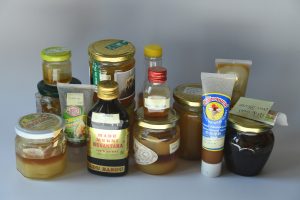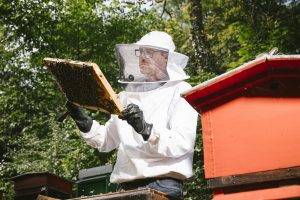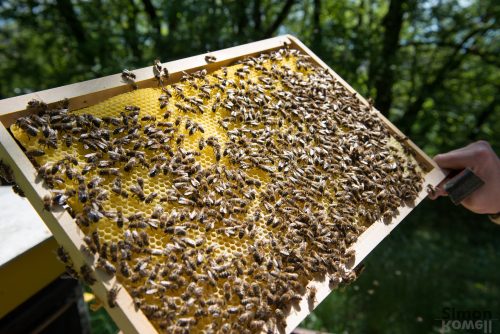As the weather gets colder, most of us love bundling up with a cup of hot tea with honey. Not only do bees provide us with delicious honey, but they also pollinate about a third of all food we eat. We admire bees as hard workers, marvel at their waggle dance, and thank them for honey and other pollinated foods. However, their population has been rapidly declining across the world due to threats such as habitat loss, disease and pesticide use.
One class of pesticides known to be toxic to pollinators is the neonicotinoids (termed “neonics”), the most widely-used class of insecticides. They affect the bees’ health, interfering with their metabolism, learning and growth. They even threaten the health of queen bees, which can be severely detrimental to colony population sizes. In a study recently published in Science, a team of researchers at University of Neuchâtel and the botanical garden of Neuchâtel found that most honey samples around the world are contaminated with these dangerous neonics.
The project stemmed from an exhibition on bees organized by the botanical garden of Neuchâtel in Switzerland. The director came up with the idea of gathering global honey samples and asked visitors, friends and colleagues who were travelling to bring back local honey. Edward Mitchell and Alexandre Aebi, researchers at University of Neuchâtel, saw the potential to use the university’s analytic capabilities to do something more with this worldwide collection of honey—and thus the collaboration began. Because of the controversy about pesticides and pollinator populations and because of neonics’ wide use and well-known effects on pollinators, they decided to construct a global map of honey exposure to neonics.
Over one hundred colleagues, friends and relatives joined forces to collect honey from every continent except Antarctica. The researchers then selected and tested almost 200 samples for five different neonics. Their results were shocking. The pesticides were found in 75% of all samples, and 45% were contaminated with more than one of the five tested compounds. The effects of exposure to this “cocktail” are still not fully understood, but such combinations are suspected to be much more lethal for bees than individual compounds alone. Additionally, levels of neonics in nearly half of the samples exceeded the lowest concentration at which they are known to be harmful to bees. The detected levels were below the limit for human consumption according to current EU regulations, although the long-term consequences of consuming these “safe” honeys are still unknown.

Image courtesy of Blaise Mulhauser
According to the researchers, the significance of their work is several-fold. “Many people will say that it is not surprising that there are pesticides in honey, but we put a figure to this; we mapped it out,” Mitchell said. Although there have been previous studies analyzing the pattern of neonics and their impact on pollinators, this study is unique in that it provides a global perspective. It was shocking, even for the researchers, that such a high percentage of honey samples from all around the world were contaminated with neonics.
Mitchell also believes that their work generates many new questions. Although the neonicotinoid levels were below the limit set by regulations on human consumption, the researchers cannot definitively say that it is safe to eat contaminated honey. “We still don’t know how consuming low concentrations of pesticide over a long period of time affects the human body,” Mitchell said. Plus, more evidence is emerging that neonics might have detrimental effects not only on non-target invertebrates but also on vertebrates, which include humans.
This study focused only on a subset of neonics—only five out of the several hundred pesticide types used throughout the world. “So, there is this big question mark about what else there is in honey, and not just in honey but even in every food we eat,” Mitchell said. Although their research cannot provide the answer, he believes it is important to continue raising these questions and conducting more research on the topic. “We should be more cautious about the way we develop and use these pesticides and look for alternatives, in case these pesticides turn out not to be absolutely essential,” he said. Neonics are used to coat seeds so that insects that later feed on the plants will be exposed to the toxic compounds. Therefore, they are used preventively to minimize future attacks, rather than as a direct response to a specific attack, which is why Aebi believes that their necessity should be reevaluated. There have already been cases in Switzerland in which a partial ban on specific pesticides did not lead to yield losses in crops, contrary to farmers’ worries.

Aebi has been a beekeeper for 15 years, in addition to being a biologist and an anthropologist. He has experienced the changes in bee population and honey first-hand. When the researchers first started the project, they wanted to develop a technique to chemically analyze the global collection of honey. They needed pure honey for their protocol, so they could contaminate it with a known concentration of neonics and calibrate their machines. Aebi recollected how he naively thought that it would be easy, assuming that his honey was pure. It turned out that his honey was contaminated with three molecules, even though he has been taking care of his bees organically. “It is not easy to keep the bees in purely harmless surroundings, because bees can travel up to twelve kilometers to collect nectar,” he said. Despite bans on neonics for certain crops, bees can still travel far away and be affected by the pesticides in other farms or private gardens.
He has also heard from his beekeeping friends that not long ago, their queen bees lived for around five years, but now the queens have to be replaced every two years. When the queens are exposed to neonics, they lose the ability to store spermatozoids, which decreases their ability to produce new bees.
As such, the effects of neonics on bees are real and detrimental. The researchers believe that political actions are crucial to minimize further damage. A total ban on all neonics is in the works in France, and partial bans are in effect throughout the EU, although their impacts are yet unknown. More research must be initiated and funded to assess such long-term consequences of pesticide exposure and regulations, and to develop new alternatives and re-analyze the necessity of these toxic compounds.
As a next step, the researchers would like to create maps for individual countries or smaller regions, and possibly for different categories of pesticides such as herbicides and fungicides. Aebi believes that analyzing changes in wild bees and populations of other organisms is also important. The researchers envision a future where both crop yields and the environment are protected, with bees happily and safely buzzing around, making honey.

